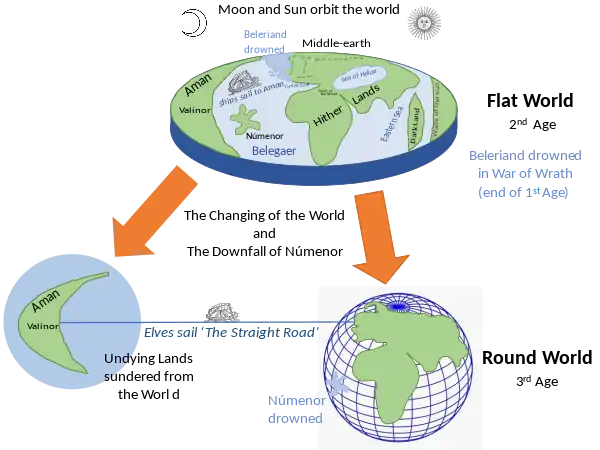Valinor
Valinor (Quenya: Land of the Valar) or the Blessed Realms is a fictional location in J. R. R. Tolkien's legendarium, the home of the immortal Valar on the continent of Aman, far to the west of Middle-earth; he used the name Aman mainly to mean Valinor. It included Eldamar, the land of the Elves, who as immortals were permitted to live in Valinor.
| Valinor | |
|---|---|
| Tolkien's legendarium location | |
| First appearance | The Lord of the Rings |
| Created by | J. R. R. Tolkien |
| In-universe information | |
| Other name(s) | The Undying Lands, Eressëa, The Deathless Lands, The Blessed Realm, The Uttermost West, Aman |
| Type | Continent |
| Ruler | Manwë |
| Characters | Valar, Elves |
| Location | On the west of The Great Sea, far to the West of Middle-earth |
Aman was known somewhat misleadingly as "the Undying Lands", but the land itself does not cause mortals to live forever.[T 1] However, only immortal beings were generally allowed to reside there. Exceptions were made for the surviving bearers of the One Ring: Bilbo and Frodo Baggins and Sam Gamgee, who dwelt there for a time, and the dwarf Gimli.[T 2][T 3]
Scholars have described the similarity of Tolkien's myth of the attempt of Númenor to capture Aman to the biblical Tower of Babel and the ancient Greek Atlantis, and the resulting destruction in both cases. They note, too, that a mortal's stay in Valinor is only temporary, not conferring immortality, just as in Dante's Paradiso, the Earthly Paradise is only a preparation for the Celestial Paradise that is above.
Others have compared the account of the beautiful Elvish part of the Undying Lands to the Middle English poem Pearl, stating that the closest literary equivalents of Tolkien's descriptions of these lands are the imrama Celtic tales such as those about Saint Brendan from the early Middle Ages. The Christian theme of good and light (from Valinor) opposing evil and dark (from Mordor) has also been discussed.
Geography
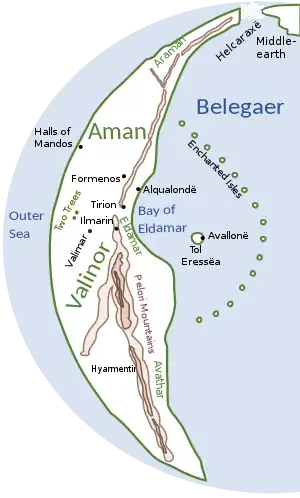
Physical
Valinor lies in Aman, a continent on the west of Belegaer, the ocean to the west of Middle-earth. Ekkaia, the encircling sea, surrounds both Aman and Middle-earth. Tolkien wrote that the name "Aman" was "chiefly used as the name of the land in which the Valar dwelt" [i.e. Valinor].[T 4] The land has a warm climate generally, though snow falls on the peaks of the Pelóri mountains, the highest being Taniquetil. Tolkien created no detailed maps of Aman; those drawn by Karen Wynn Fonstad, based on Tolkien's rough sketch of Arda's landmasses and seas, show Valinor about 800 miles wide, west to east (from the Great Sea to the Outer Sea), and about 3000 miles long north to south – similar in size to the United States. The entire continent of Aman runs from the Arctic latitudes of the Helcaraxë to the subarctic southern region of Middle-earth – about 7000 miles.[1][2]
Eldamar is "Elvenhome", the "coastal region of Aman, settled by the Elves", wrote Tolkien.[T 5][3] Eldamar was the true Eldarin name of Aman.[T 6] In The Hobbit it is referred to as "Faerie". The land was well-wooded, as Finrod "walk[ed] with his father under the trees in Eldamar" and the Teleri had timber to build their ships. The city of the Teleri, on the north shore of the Bay is Alqualondë, the Haven of the Swans, whose halls and mansions are made of pearl. The harbour is entered through a natural arch of rock, and the beaches are strewn with gems given by the Noldor.[T 7] In the bay is the island of Tol Eressëa.[T 8]
Calacirya (Quenya: "Light Cleft", for the light of the Two Trees that streamed through the pass into the world beyond) is the pass in the Pelóri mountains where the Elven city Tirion was set. After the hiding of Valinor, this was the only gap through the mountains of Aman. The Valar would have closed the mountains entirely but, realizing that the Elves needed to be able to breathe the outside air, they kept Calacirya open. They also did not want to wholly separate the Vanyar and Noldor from the Teleri on the coast.[T 8][2]
The city of the Noldor (and for a time the Vanyar also) is Tirion, which was built on the hill of Túna, raised inside the Calacirya mountain pass, just north of Taniquetil, facing both the Two Trees and the starlit seas. The city had a central square at the top of the hill and a tower called the Mindon Eldaliéva, a beacon visible from the seashore miles to the east.[T 9]
In the extreme north-east, beyond the Pelóri, was the Helcaraxë, a vast ice sheet that joined the two continents of Aman and Middle-earth before the War of Wrath.[T 10] To prevent anyone from reaching the main part of Valinor's east coast by sea, the Valar created the Shadowy Seas, and within these seas they set a long chain of islands called the Enchanted Isles.[T 11]
Political
Valinor is the home of the Valar (singular Vala), spirits that often take humanoid form, sometimes called "gods" by the Men of Middle-earth.[T 12] Other residents of Valinor include the related but less powerful spirits, the Maiar, and most of the Eldar.[T 13]
Each Vala has his or her own region of the land. The Mansions of Manwë and Varda, two of the most powerful spirits, stood upon Taniquetil, the highest mountain of the Pelóri.[2] Yavanna, the Vala of Earth, Growth, and Harvest, resided in the Pastures of Yavanna in the south of the land, west of the Pelóri. Near-by were the mansions of Yavanna's spouse, Aulë the Smith, who made the Dwarves.[T 14] Oromë, the Vala of the Hunt, lived in the Woods of Oromë to the north-east of the pastures. Nienna, the lonely Vala of Sorrow and Endurance, lived in the far west of the island where she spent her days crying about all the evil of the world, looking out to sea. Just south of Nienna's home, and to the north of the pastures, were the Halls of Mandos. Mandos was the Vala of the After-life. Also living in the Halls of Mandos was his spouse Vairë the weaver, who weaves the threads of time. To the east of the Halls of Mandos is the Isle of Estë, which is situated in the middle of the lake of Lórellin, which in turn lies to the north of the Gardens of Lórien.[lower-alpha 1][2]
In east-central Valinor at the Girdle of Arda (the Equator of Tolkien's world) is Valmar, the capital of Valinor (also called Valimar or the City of Bells), the residence of the Valar and the Maiar in Valinor. The first house of the Elves, the Vanyar, settled there as well. The mound of Ezellohar, on which stood the Two Trees, and Máhanaxar, the Ring of Doom, are outside Valmar.[T 13] Farther east is the Calacirya, the only easy pass through the Pelóri, a huge mountain range fencing Valinor on three sides, created to keep Morgoth's forces out. In the pass is the city Tirion, built on a hill, the city of the Noldor Elves.[2]
In the northern inner foothills of the Pelóri, hundreds of miles north of Valmar, was Fëanor's city of Formenos, built upon his banishment from Tirion.[2]
History
Years of the Trees
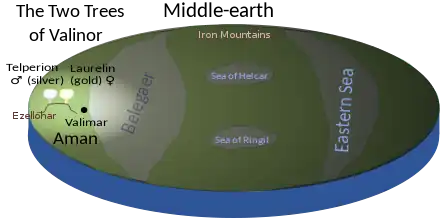
Valinor was established on the western continent Aman when Melkor (a Vala later named Morgoth, "the black foe", by the Elves) destroyed the Valar's original home on the island Almaren in primeval Middle-earth, ending the Years of the Lamps.[T 13] To defend their new home from attack, they raised the Pelóri Mountains. They also established Valimar, the radiant Two Trees, and their dwelling-places. Valinor was said to have surpassed Almaren in beauty. Later, the Valar heard of the awakening of the Elves in Middle-earth, where Melkor was unopposed. They proposed to bring the Elves to the safety of Valinor, but to do that, they needed to get Melkor out of the way. A war was fought, and Melkor's stronghold Utumno was destroyed. Then, many Elves came to Valinor, and established their cities Tirion and Alqualondë, beginning Valinor's age of glory. But Melkor had come back to Valinor as a prisoner, and after three Ages was brought before the Valar and he sued for pardon, vowing to assist the Valar and make amends for the hurts he had done. Manwë granted him pardon, but confined him within Valmar to remain under watch. After his release, Melkor started planting seeds of dissent in the minds of the Elves, including between Fëanor and his brothers Fingolfin and Finarfin. Fëanor used some of the light of the Two Trees to forge the three Silmarils, beautiful and irreplaceable jewels.[2]
The Darkening of Valinor
Belatedly, the Valar learned what Melkor had done. Knowing that he was discovered, Melkor went to the home of the Noldorin elves' High King Finwë, killed him and stole the prized jewels, the Silmarils. He then destroyed the Two Trees with the help of Ungoliant, plunging Valinor into darkness, the Long Night, relieved only by stars. Melkor and Ungoliant fled to Middle-earth.[T 15]
The Hiding of Valinor
The Valar managed to save one last luminous flower from Telperion, and one last luminous fruit from Laurelin. These became the Moon and the Sun. The Valar carried out further titanic labours to improve the defences of Valinor. They raised the Pelóri mountains to even greater and sheerer heights. Off the coast, eastwards of Tol Eressëa, they created the Shadowy Seas and their Enchanted Isles; both the Seas and the Isles presented numerous perils to anyone attempting to get to Valinor by sea.[T 11][2]
Later history
For centuries Valinor took no part in the struggles between the Noldor and Morgoth in Middle-earth. But near the end of the First Age, when the Noldor were in total defeat, the mariner Eärendil convinced the Valar to make a last attack on Morgoth. A mighty host of Maiar, Vanyar and the remaining Noldor in Valinor destroyed Morgoth's gigantic army and his stronghold Angband, and cast Morgoth into the void.[T 16]
During the Second Age, the Valar created the island of Númenor as a reward to the Edain, Men who had fought alongside the Noldor. Centuries later the kingdom of Númenor grew so powerful and so arrogant that Ar-Pharazôn, the twenty-fifth and last king, dared to attempt an invasion of Valinor. When Eru Ilúvatar responded to the call of the Valar, Númenor sank into the sea, and Aman was removed beyond the reach of the Men of Arda. Arda itself became spherical, and was left for Men to govern. The Elves could go there only by the Straight Road and in ships capable of passing out of the spheres of the earth.[T 17][2][4]
Analysis
Paradise
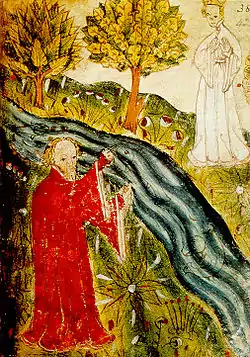
Keith Kelly and Michael Livingston, writing in Mythlore, note that Frodo's final destination is Aman, the Undying Lands. In Tolkien's mythology, they write, the islands of Aman were initially just the dwelling-places of the Valar (in the Ages of the Trees, while the rest of the world lay in darkness) who helped The One, Eru Iluvatar, to create the world, but gradually some of the immortal and ageless Elves were allowed to live there as well, sailing across the ocean to the West. After the fall of Númenor and the reshaping of the world, Aman becomes the place "between (sic) Over-heaven and Middle-earth",[6] accessible only in special circumstances like Frodo's, allowed to come to Aman through the offices of the Valar and of Gandalf, one of the Valar's emissaries, the Maiar. However, Aman is not, they write, exactly paradise: firstly, being there does not confer immortality, contrary to what the Númenóreans supposed; and secondly, those mortals like Frodo who are allowed to go there will eventually choose to die. They note that in another of Tolkien's writings, Leaf by Niggle, understood to be a journey through Purgatory (the Catholic precursor stage to paradise), Tolkien avoids describing paradise at all; they suggest that to the Catholic Tolkien, it is impossible to describe Heaven, and it might be sacrilege to make the attempt.[6] The Tolkien scholar Michael D. C. Drout comments that Tolkien's accounts of Eldamar "give us a good idea of his conceptions of absolute beauty,"[5] and notes that these resemble the paradise described in the Middle English poem Pearl.[5]
| Tolkien | Catholicism | Pearl, Dante's Paradiso |
|---|---|---|
| "that which is beyond Elvenhome and will ever be"[T 18] | Heaven | Celestial Paradise, "beyond" |
| Undying lands of Aman, Elvenhome in Valinor | Purgatory | Earthly Paradise, Garden of Eden |
| Middle-earth | Earth | Earth |
The Tolkien scholar Tom Shippey adds that in 1927 Tolkien wrote a poem, The Nameless Land, in the complex stanza-form of Pearl which spoke of a land further away than paradise, and more beautiful than the Irish Tir nan Og, the deathless otherworld.[4] Kelly and Livingston similarly draw on Pearl, noting that it states that "fair as was the hither shore, far lovelier was the further land"[6] where the Dreamer could not pass. So, they write, each stage looks like paradise, until the traveller realises that beyond it lies something even more paradisiacal, glimpsed and beyond description. The Earthly Paradise can be described; Aman, the Undying Lands, can thus be compared to the Garden of Eden, the paradise that the Bible says once existed upon Earth before the Fall of Man, while the Celestial Paradise lies "beyond (or above)", as it does, they note, in Dante's Paradiso.[6][7]

Good against evil
The scholar of English literature Marjorie Burns writes that one of the female Vala, Varda (Elbereth to the Elves) is sung to by the Elf-queen of Middle-earth Galadriel. Burns notes that Varda "sits far off in Valinor on Oiolossë",[9] looking from her mountain-peak tower in Aman towards Middle-earth and the Dark Tower of Sauron in Mordor: in her view, the white benevolent feminine symbol opposing the evil masculine symbol. Further, Burns suggests, Galadriel is an Elf from Valinor "in the Blessed Realm",[9] bringing Varda's influence with her to Middle-earth. This is seen in the phial of light that she gives to Frodo, and that Sam uses to defeat the evil giant spider Shelob: Sam invokes Elbereth when he uses the phial. Burns comments that Sam's request to the "Lady" sounds distinctly Catholic, and that the "female principle, embodied in Varda of Valinor and Galadriel of Middle-earth, most clearly represents the charitable Christian heart."[9]
Original sin
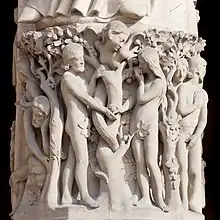
The scholar of literature Richard Z. Gallant comments that while Tolkien made use of pagan Germanic heroism in his legendarium, and admired its Northern courage, he disliked its emphasis on "overmastering pride", which he saw as a sin in Christian terms. This created a conflict in his writing. Further, the prideful sin of the Elves in Valinor, which to his mind was analogous to the original sin of Adam and Eve in the Book of Genesis, inevitably resulted in a fall analogous to the biblical fall of man. Tolkien described this by saying "The first fruit of their fall was in Paradise [Valinor], the slaying of Elves by Elves"; Gallant interprets this as an allusion to the fruit of the biblical tree of knowledge of good and evil and the resulting exit from the Garden of Eden, starting with Fëanor.[T 19][10] His actions, Gallant writes, set off the whole dark narrative of strife among the Elves described in The Silmarillion; the Elves fight and leave Valinor for Middle-earth.[10]
Lost home
Phillip Joe Fitzsimmons compares The Silmarillion's faraway Valinor, forbidden to Men and lost to the Elves, though it constantly calls to them to return, to Tolkien's fellow-Inkling, Owen Barfield's "lost home". Barfield writes of the loss of "an Edenic relationship with nature", part of his theory that man's purpose is to serve as " the Earth’s self-consciousness".[11] Barfield argued that rationalism creates individualism, "unhappy isolation ... [and] the loss of a mutual relationship with nature."[11] Further, Barfield believed that ancient civilisations, as recorded in their languages, had a connection to and inner experience of nature, so that the modern situation represents a loss of that state of grace. Fitzsimmons states that the lost home motif recurs throughout Tolkien's writings. He does not suggest that Barfield influenced Tolkien, but that the ideas of the two men grew from "the same time, place, and even social circle".[11]
Atlantis, Babel
Kelly and Livingston state that while Aman could be home to Elves as well as Valar, the same was not true of mortal Men. The "prideful"[6] Men of Númenor, imagining they could acquire immortality by capturing the physical lands of Aman, were punished by the destruction of their own island, which is engulfed by the sea, and the permanent removal of Aman "from the circles of the world".[6] Kelly and Livingston note the similarity to the ancient Greek myth of Atlantis, the greatest human civilisation lost beneath the sea; and the resemblance to the biblical tale of the Tower of Babel, the hubristic and "sacrilegious" attempt by mortal men to climb up into God's realm.[6]
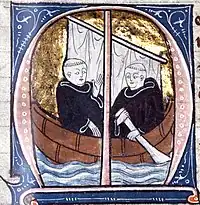
Celtic influence
The scholar of English literature Paul H. Kocher writes that the Undying Lands of the Uttermost West including Eldamar and Valinor, is "so far outside our experience that Tolkien can only ask us to take it completely on faith."[12] Kocher comments that these lands have an integral place both geographically and spiritually in Middle-earth, and that their closest literary equivalents are the imrama Celtic tales from the early Middle Ages. The imrama tales describe how Irish adventurers such as Saint Brendan sailed the seas looking for the "Land of Promise". He notes that it is certain that Tolkien knew these stories, since in 1955 he wrote a poem, entitled Imram, about Brendan's voyage.[12][4]
See also
- Asgard and Álfheimr in Norse mythology
- Elysium and Mount Olympus in Greek mythology
Notes
- Not to be confused with Lothlórien in Middle-earth.
References
Primary
- Carpenter 1981, #156 to Father R. Murray, SJ, November 1954
- Tolkien 1955, "The Grey Havens", and Appendix B, entry for S.R. 1482 and 1541.
- Carpenter 1981, #249 to Michael George Tolkien, October 1963
- Tolkien 1994, "Quendi and Eldar".
- Kept in a folder labelled "Phan, Mbar, Bal and other Elvish etymologies", published in Parma Eldalamberon, 17.
- Parma Eldalamberon, 17, p. 106.
- Tolkien 1977, ch. 9 "Of the Flight of the Noldor"
- Tolkien 1977, ch. 5 "Of Eldamar and the Princes of the Eldalië"
- Tolkien 1977, ch. 7 "Of the Silmarils and the Unrest of the Noldor"
- Tolkien 1977, ch. 3 "Of the Coming of the Elves and the Captivity of Melkor"
- Tolkien 1977, ch. 11 "Of the Sun and Moon and the Hiding of Valinor"
- Tolkien 1977, "Valaquenta"
- Tolkien 1977, ch. 1 "Of the Beginning of Days"
- Tolkien 1977, ch. 2 "Of Aulë and Yavanna"
- Tolkien 1977, ch. 8 "Of the Darkening of Valinor"
- Tolkien 1977, ch. 24 "Of the Voyage of Eärendil and the War of Wrath"
- Tolkien 1977, "Akallabêth"
- Tolkien 1955, book 6, ch. 4 "The Field of Cormallen"
- Carpenter 1981, #131 to Milton Waldman, late 1951
Secondary
- Fonstad 1991.
- Oberhelman 2013.
- Tyler 2002, pp. 307–308.
- Shippey 2005, pp. 324–328.
- Drout 2007.
- Kelly & Livingston 2009.
- Dickerson 2007.
- Shippey 2005, pp. 269–272.
- Burns 2005, pp. 152–154.
- Gallant 2014, pp. 109–129.
- Fitzsimmons 2016, pp. 1–8.
- Kocher 1974.
Sources
- Burns, Marjorie (2005). Perilous Realms: Celtic and Norse in Tolkien's Middle-earth. University of Toronto Press. pp. 152–154 (Elbereth/Varda in Valinor vs Galadriel in Middle-earth, formerly of Valinor). ISBN 978-0802038067.
- Carpenter, Humphrey, ed. (1981). The Letters of J. R. R. Tolkien. Boston: Houghton Mifflin. ISBN 978-0-395-31555-2.
- Dickerson, Matthew T. (2007). "Paradise". In Drout, Michael D. C. (ed.). The J. R. R. Tolkien Encyclopedia. CRC Press. pp. 502–503. ISBN 978-0-415-96942-0.
- Drout, Michael D. C. (2007). "Eldamar". In Drout, Michael D. C. (ed.). The J. R. R. Tolkien Encyclopedia. CRC Press. p. 145. ISBN 978-0-415-96942-0.
- Fitzsimmons, Phillip Joe (2016). "Glimpses of lost home in the works of J.R.R. Tolkien and Owen Barfield". Faculty Articles & Research (3).
- Fonstad, Karen Wynn (1991). The Atlas of Middle-earth. Boston: Houghton Mifflin Harcourt. Lothlórien. ISBN 0-618-12699-6.
- Gallant, Richard Z. (2014). "Original Sin in Heorot and Valinor". Tolkien Studies. 11 (1): 109–129. doi:10.1353/tks.2014.0019.
- Kelly, A. Keith; Livingston, Michael (2009). "'A Far Green Country: Tolkien, Paradise, and the End of All Things in Medieval Literature". Mythlore. 27 (3).
- Kocher, Paul (1974) [1972]. Master of Middle-earth: The Achievement of J.R.R. Tolkien. Penguin Books. pp. 14–18 and 79–82 (Valinor, Eldamar, Undying Lands, origins in Celtic tales). ISBN 0140038779.
- Oberhelman, David D. (2013) [2006]. "Valinor". In Drout, Michael D. C. (ed.). The J. R. R. Tolkien Encyclopedia. Routledge. pp. 692–693. ISBN 978-0-415-96942-0.
- Shippey, Tom (2005) [1982]. The Road to Middle-earth (Third ed.). The Lost Straight Road: HarperCollins. pp. 324–328. ISBN 978-0261102750.
- Tolkien, J. R. R. (1955). The Return of the King. The Lord of the Rings. Boston: Houghton Mifflin. OCLC 519647821.
- Tolkien, J. R. R. (1977). Christopher Tolkien (ed.). The Silmarillion. Boston: Houghton Mifflin. ISBN 978-0-395-25730-2.
- Tolkien, J. R. R. (1994). Christopher Tolkien (ed.). The War of the Jewels. Boston: Houghton Mifflin. ISBN 0-395-71041-3.
- Tyler, J. E. A. (2002). The Complete Tolkien Companion. Pan Books. ISBN 978-0-330-41165-3.
